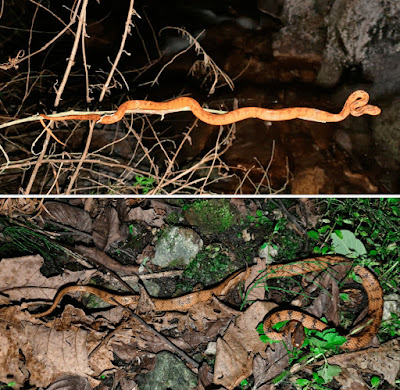Abstract
We describe a new species of the genus Pareas, based on three specimens collected from Guanyinshan Provincial Nature Reserve in Yuanyang County, Honghe Prefecture, Yunnan Province, China. The new species is distinguished from its congeners by one preocular, one postocular or postocular fused with subocular, loreal not bordering the orbit, one row enlarged vertebral scales, five rows keeled mid-dorsal scales at the middle of the body, 189–192 ventral scales and 72–89 subcaudal scales. The dorsal surfaces of the head and body are yellowish red or yellowish brown, and the belly and ventral surfaces of the head and tail are pinkish yellow or yellow with more or less small black spots. Phylogenetic analyses of mitochondrial DNA recovered the new species being the sister taxon to P. hamptoni sensu stricto. The genetic divergences between the new species and P. hamptoni sensu stricto were 4.2% in the Cyt b sequences and 5.0% in the ND4 sequences. In addition, based on specimens collected from Honghe and Wenshan prefectures, we confirmed that P. hamptoni sensu stricto is distributed in China.
Keywords: Cyt b; morphology; ND4; Pareas guanyinshanensis sp. nov.; taxonomy
Class Reptilia Laurenti, 1768
Order Squamata Oppel, 1811
Suborder Serpentes Linnaeus, 1758
Infraorder Caenophidia Hoffstetter, 1939
Family Pareidae Romer, 1956
Subfamily Pareinae Romer, 1956
Genus Pareas Wagler, 1830
Subgenus Eberhardtia Angel, 1920
Pareas guanyinshanensis sp. nov.
 |
| Pareas guanyinshanensis sp. nov. in life. (A) The holotype (KIZ 2023038); (B) the paratype (KIZ 2023040). |
Diagnosis. SVL 482–540 mm, TL/SVL 0.26–0.30; prefrontal bordering orbit; loreal not bordering orbit; 1 preocular; 1 postocular or postocular fused with subocular; 7–8 supralabials; 6–8 infralabials; infralabial not fused with chin-shield; 3 chin-shield pairs; dorsal scales in 15 rows throughout; 1 row of vertebral scales enlarged; scales not keeled at anterior part of body, 5 rows of mid-dorsal scales keeled at middle part of body, 5–7 rows of mid-dorsal scales keeled at posterior part of body; ventral scales 189–192; subcaudals 72–89, paired; precloacal plate undivided; maxillary teeth 4–5. Dorsal surface of head dark yellowish red or yellowish brown, with dense small black spots; dorsal surface of body yellowish red or yellowish brown; belly and ventral surfaces of head and tail pinkish yellow or yellow, with more or less small black spots; iris reddish yellow or yellow.
Etymology. The specific epithet guanyinshanensis refers to Guanyinshan Provincial Nature Reserve [Yuanyang County, Honghe Prefecture, Yunnan Prov.], where the new species was found.
Shuo Liu, Mingzhong Mo, Mei Li, Biao Li, Xiong Luo, Dingqi Rao and Song Li. 2024. Description of A New Species of the Pareas hamptoni Complex from Yunnan, China, with Confirmation of P. hamptoni Sensu Stricto in China (Squamata, Pareidae). Animals. 2024, 14(3), 421. DOI: 10.3390/ani14030421
Simple Summary: In this paper, a new Pareas species of the P. hamptoni complex is described from southern Yunnan Province, China, based on morphological and molecular evidence. Genetically, the new species is most closely related to P. hamptoni sensu stricto, for which we confirm the distribution in China. Morphologically, the new species can be distinguished from P. hamptoni sensu stricto and all other congeners by a combination of morphological characteristics. The discovery of the new species brings the total number of recognized species of the genus Pareas to 31, of which 25 occur in China.

